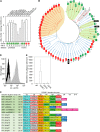Acquisition of IgG to ICAM-1-Binding DBLβ Domains in the Plasmodium falciparum Erythrocyte Membrane Protein 1 Antigen Family Varies between Groups A, B, and C
- PMID: 31308082
- PMCID: PMC6759304
- DOI: 10.1128/IAI.00224-19
Acquisition of IgG to ICAM-1-Binding DBLβ Domains in the Plasmodium falciparum Erythrocyte Membrane Protein 1 Antigen Family Varies between Groups A, B, and C
Abstract
Plasmodium falciparum erythrocyte membrane protein 1 (PfEMP1) is an important malaria virulence factor. The protein family can be divided into clinically relevant subfamilies. ICAM-1-binding group A PfEMP1 proteins also bind endothelial protein C receptor and have been associated with cerebral malaria in children. IgG to these PfEMP1 proteins is acquired later in life than that to group A PfEMP1 not binding ICAM-1. The kinetics of acquisition of IgG to group B and C PfEMP1 proteins binding ICAM-1 is unclear and was studied here. Gene sequences encoding group B and C PfEMP1 with DBLβ domains known to bind ICAM-1 were used to identify additional binders. Levels of IgG specific for DBLβ domains from group A, B, and C PfEMP1 binding or not binding ICAM-1 were measured in plasma from Ghanaian children with or without malaria. Seven new ICAM-1-binding DBLβ domains from group B and C PfEMP1 were identified. Healthy children had higher levels of IgG specific for ICAM-1-binding DBLβ domains from group A than from groups B and C. However, the opposite pattern was found in children with malaria, particularly among young patients. Acquisition of IgG specific for DBLβ domains binding ICAM-1 differs between PfEMP1 groups.
Keywords: PfEMP1; Plasmodium falciparum; antibodies; immunity; malaria.
Copyright © 2019 Olsen et al.
Figures





Similar articles
-
Cerebral Plasmodium falciparum malaria: The role of PfEMP1 in its pathogenesis and immunity, and PfEMP1-based vaccines to prevent it.Immunol Rev. 2020 Jan;293(1):230-252. doi: 10.1111/imr.12807. Epub 2019 Sep 27. Immunol Rev. 2020. PMID: 31562653 Free PMC article. Review.
-
Natural and Vaccine-Induced Acquisition of Cross-Reactive IgG-Inhibiting ICAM-1-Specific Binding of a Plasmodium falciparum PfEMP1 Subtype Associated Specifically with Cerebral Malaria.Infect Immun. 2018 Mar 22;86(4):e00622-17. doi: 10.1128/IAI.00622-17. Print 2018 Apr. Infect Immun. 2018. PMID: 29426042 Free PMC article.
-
PfEMP1 A-Type ICAM-1-Binding Domains Are Not Associated with Cerebral Malaria in Beninese Children.mBio. 2020 Nov 17;11(6):e02103-20. doi: 10.1128/mBio.02103-20. mBio. 2020. PMID: 33203751 Free PMC article.
-
IgG acquisition against PfEMP1 PF11_0521 domain cassette DC13, DBLβ3_D4 domain, and peptides located within these constructs in children with cerebral malaria.Sci Rep. 2021 Feb 11;11(1):3680. doi: 10.1038/s41598-021-82444-5. Sci Rep. 2021. PMID: 33574457 Free PMC article.
-
PfEMP1 - A Parasite Protein Family of Key Importance in Plasmodium falciparum Malaria Immunity and Pathogenesis.Adv Parasitol. 2015 Apr;88:51-84. doi: 10.1016/bs.apar.2015.02.004. Epub 2015 Mar 23. Adv Parasitol. 2015. PMID: 25911365 Review.
Cited by
-
Plasmodium falciparum VAR2CSA-Specific IgG Subclass Responses Reflect Protection Against Low Birth Weight and Pregnancy-Associated Malaria.Front Immunol. 2021 Apr 21;12:610305. doi: 10.3389/fimmu.2021.610305. eCollection 2021. Front Immunol. 2021. PMID: 33968015 Free PMC article.
-
Expression of Single-Domain Soluble and Disulfide-Folded PfEMP1 Antigens in the Escherichia coli SHuffle Expression System.Methods Mol Biol. 2022;2470:273-282. doi: 10.1007/978-1-0716-2189-9_20. Methods Mol Biol. 2022. PMID: 35881352
-
Different PfEMP1-expressing Plasmodium falciparum variants induce divergent endothelial transcriptional responses during co-culture.PLoS One. 2023 Nov 30;18(11):e0295053. doi: 10.1371/journal.pone.0295053. eCollection 2023. PLoS One. 2023. PMID: 38033133 Free PMC article.
-
Cerebral Plasmodium falciparum malaria: The role of PfEMP1 in its pathogenesis and immunity, and PfEMP1-based vaccines to prevent it.Immunol Rev. 2020 Jan;293(1):230-252. doi: 10.1111/imr.12807. Epub 2019 Sep 27. Immunol Rev. 2020. PMID: 31562653 Free PMC article. Review.
-
ICAM-1-binding Plasmodium falciparum erythrocyte membrane protein 1 variants elicits opsonic-phagocytosis IgG responses in Beninese children.Sci Rep. 2022 Jul 29;12(1):12994. doi: 10.1038/s41598-022-16305-0. Sci Rep. 2022. PMID: 35906450 Free PMC article.
References
-
- Su X, Heatwole VM, Wertheimer SP, Guinet F, Herrfeldt JA, Peterson DS, Ravetch JA, Wellems TE. 1995. The large diverse gene family var encodes proteins involved in cytoadherence and antigenic variation of Plasmodium falciparum-infected erythrocytes. Cell 82:89–100. doi:10.1016/0092-8674(95)90055-1. - DOI - PubMed
-
- Smith JD, Chitnis CE, Craig AG, Roberts DJ, Hudson-Taylor DE, Peterson DS, Pinches R, Newbold CI, Miller LH. 1995. Switches in expression of Plasmodium falciparum var genes correlate with changes in antigenic and cytoadherent phenotypes of infected erythrocytes. Cell 82:101–110. doi:10.1016/0092-8674(95)90056-x. - DOI - PMC - PubMed
Publication types
MeSH terms
Substances
Grants and funding
LinkOut - more resources
Full Text Sources
Research Materials
Miscellaneous

